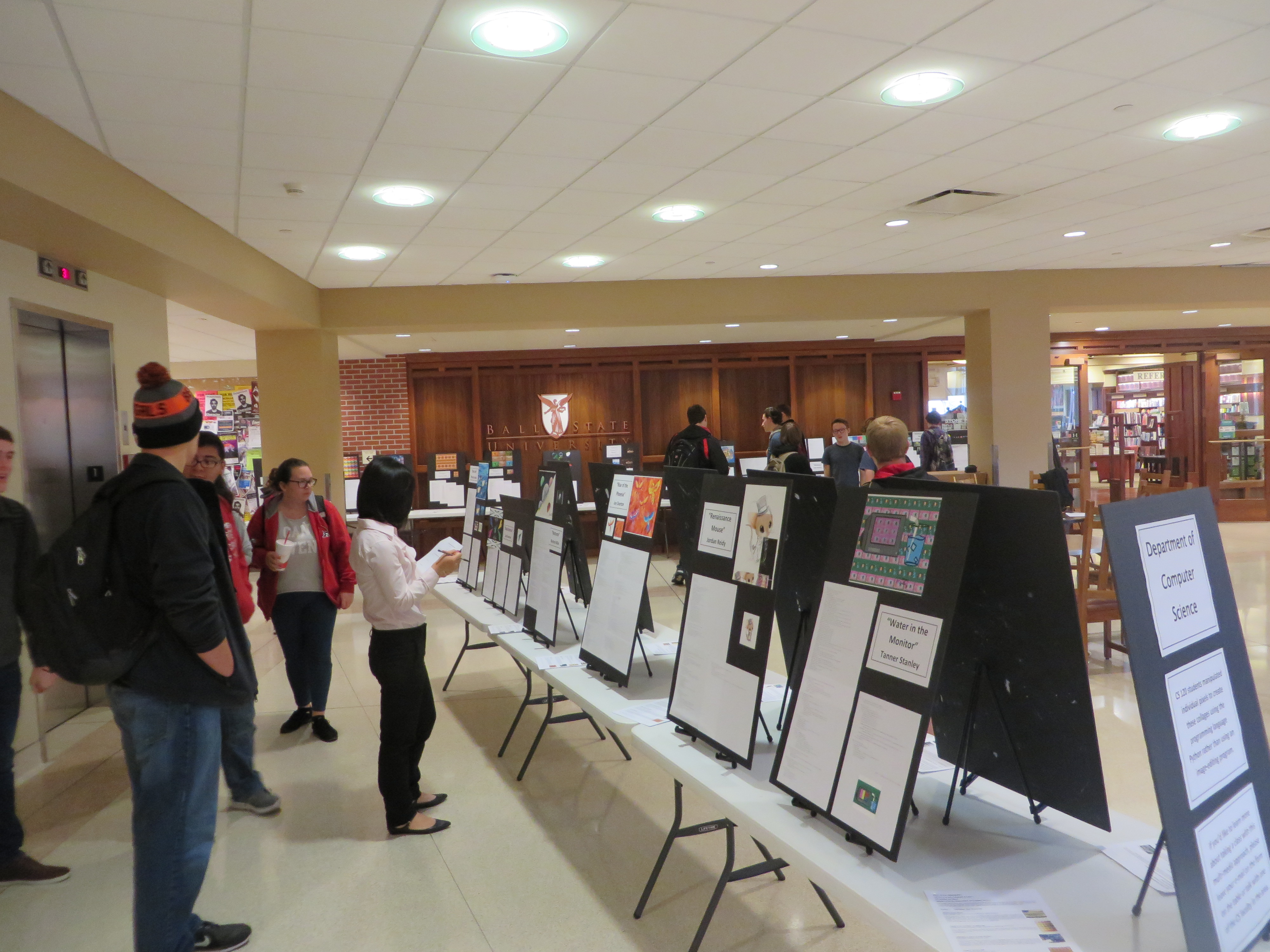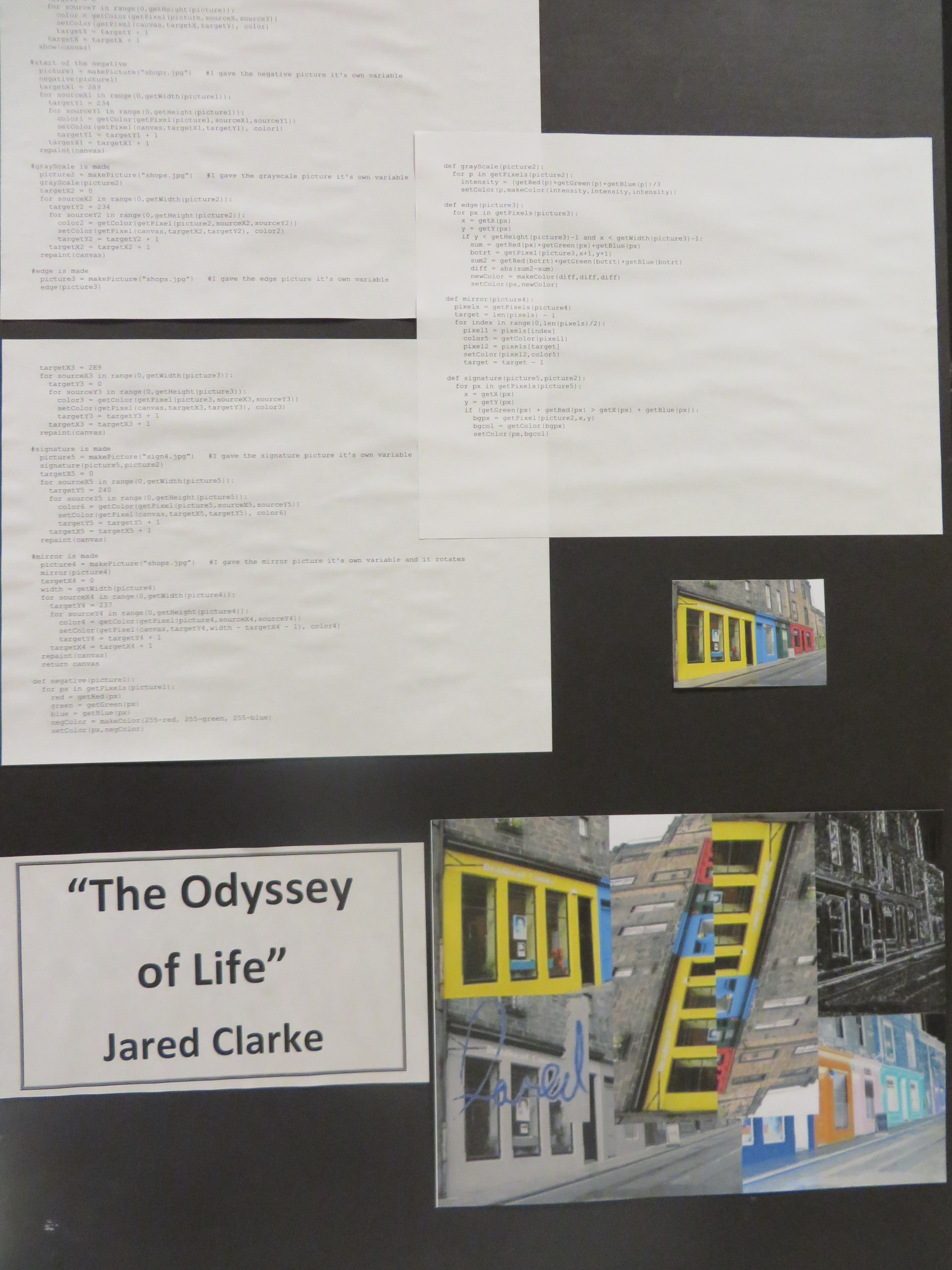
Academic web page |
dllargent@bsu.edu
Ball State University |
Department of Computer Science
| Summary | Students write a program that creates a picture collage of modified images. The project is open-ended, but the completed code and collage must meet a set of minimum requirements to earn full credit. In addition to the project being assessed, the collages created by the submitted projects are judged by peers within each section of the course, with the best advancing to a public all-section art show. Awards are given for the best at the all-section art show. |
| Topics |
|
| Audience | Mid CS1 students |
| Difficulty | Moderate. It is designed so the student can show all they have learned during the first half of the semester. |
| Strengths |
|
| Weaknesses |
|
| Dependencies | Requires an image manipulation library. Since we are using the Guzdial/Ericson Python textbook, we utilize the library provided with their JES programming environment. |
| Variants |
|
To start with, this is simply a middle-of-the-semester project the students submit for a grade. It is at the end of teaching image manipulation, and thus provides an opportunity for the students to demonstrate what they have learned thus far. Students write a program that creates a picture collage of modified images. The project is open-ended in that they can create any image they want, but the completed code and collage must meet a set of minimum requirements to earn full credit.
In addition to the project being assessed, every collage created by the submitted projects is judged by the students within each section of the course. (We typically have 3-5 sections each semester.) Those collages selected as the best ones from each section advance to a public all-section art show. Further judging occurs at this level by department professors, and individuals from other parts of the university, with awards being given for the best collages at the all-section art show.
The all-section art show helps to raise visibility of the our department within the university. It also highlights the ability to be creative in a computer science degree program. Many of the students are motivated to be creative and more engaged. It also provides a venue in which beginning CS students can showcase their work to their peers and others.
Section judging: We have two rounds of in-class peer (student) voting. (Example round 1 and 2 evaluation forms are provided below.) I print out each collage in color on a half sheet of paper, label each one with a unique identifying letter, and tape them up on the wall around the room on voting day. All submissions are entered in round one of the student voting. Roughly the top third (I look for a break in the vote counts) advance to the second round of student voting. The second round of student voting determines which entries advance to the all-section art show. We have between 15-25% of the students from each section advance. The percentage varies because of the limited space we have in our public venue, we shoot for having roughly 25 entrants. The selected students are given four days to make minor improvements to their program based on grading feedback, and resubmit it for the all-section art show. This selection process models the review/selection process for academic paper submission. Each entrant is required to sign the FERPA release form (see below).
Poster creation: A poster for each all-section art show entrant is created by the graduate assistants, or instructors. Each poster includes the student's name, a title for the collage, an 8.5" x 11" color print of the collage, a small (approximately 2” x 3”) print of the original image(s) used, and the printed code that creates the collage.

Attendance: I've traditionally not held class in the classroom on the day of the all-section art show, but rather required the students to attend the show (at least) long enough to sign an attendance sheet. My experience is that most of them stay much longer, and enjoy looking at other section's submissions. This also allows the students whose submissions are being displayed to be present and thus interact with those looking at their collages.
Judging: For the all-section art show, I recruit judges from a variety of sources: CS professors, professors from other departments, administrators, and sometimes upper-division students. All judges are asked to evaluate each entrant on an aesthetics level. Those judges that have a programming background, are also asked to evaluate the code qualtiy. Instructions and forms are provided to the judges (see below). After the show, I send a thank you card to each judge.
Show handout/web page: I create a show handout for the all-section art show (see below). This document contains a small thumbnail of the collage image, the student's name, major, and a brief artist statement. A limited number of copies are printed and made available at the show. I also create a webpage showing all entrants to the all-setion art show with the same information as is provided on the handout. After the show, I create a companion web page to honor the winners. A link to the web pages is provided below in the samples section.
Promotion: Each semester I have reached out to our school newspaper and our local newspaper to provide them details about the all-section art show. A few semesters we have been covered, so I keep notifying them. We also send out an email notice to the entire campus.
This assignment and art show was presented at the 2019 SIGCSE Symposium as a poster. Two related files are available:
This assignment and art show was inspired by this article:
Leo Porter and Beth Simon. 2013. "Fostering creativity in CS1 by hosting a computer
science art show". ACM Inroads 4, 1 (March 2013), 29-31.
DOI: doi.org/10.1145/2432596.2432609
The textbook used for this class is:
Guzdial, M. and Ericson, B. Introduction to Computing and Programming in Python:
A Multimedia Approach (4th edition). (Hoboken, NJ: Pearson Higher Education, 2016.)
Previous semesters' entrants and winners in the all-section art shows.